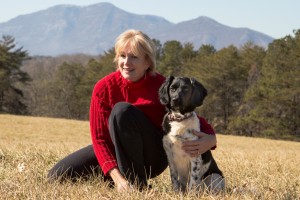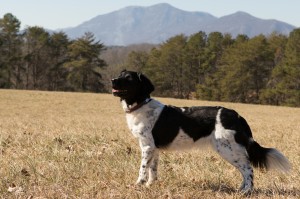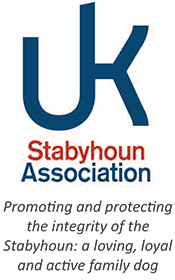
Judy with her beloved Suffie
Following two 20-hour matchmaking round-trips to Maryland, Judy Wiltsek and her family could soon be welcoming a litter of extremely rare Stabyhoun puppies to her home in Mill Spring, North Carolina.
Widely considered amongst the world’s top ten rarest dog breeds, the Stabyhoun has a population numbering just 6,000 globally. Now, small animal vet and dog trainer, Judy, is determined to increase the population of her beloved Stabyhoun in the US, where just 300 dogs comprise the entire North American count. Alongside American and Dutch breed experts, Judy has scoured the country for a suitable mate for her dog Suffie and has just returned from her second date with all fingers crossed: “With just 6,000 Stabyhoun in the entire world according to the last count, it is important that efforts are made to preserve this wonderful breed and we are very excited to play a part in that,” she explains.
Originating in Friesland, a province in northern Netherlands, Stabyhouns were originally bred as an all-round farm dog with a gentle temperament and a knack for catching moles. Despite their relative scarcity compared to more common breeds, the Stabyhoun is considered a Dutch national treasure and is growing in popularity across Northern Europe and North America. The more renown Friesian horses came from this very same part of The Netherlands.
Judy bought her first Stabyhoun ten years ago and has travelled to Holland several times to the breed’s homeland to import puppies of what she describes as one of the most emotionally intelligent breeds she has ever known. That is because, to date, the number of litters born in North American can nearly be counted on two hands.
Judy and husband Michael were keen for their two children to grow up with dogs and after a few years with a Shetland Sheepdog bought when their daughter Lauren was 5 years old, they sought a slightly bigger and sturdier dog as a companion for their son, Casey. Michael brought out the Dog Breed Encyclopedia and when the couple spotted this black and white Friesian gem, it was love at first sight.
With just over 300 Stabyhoun in the United States and Canada combined, most families face having to travel great distances – even crossing the Atlantic Ocean – to buy a puppy. With the foundation of the Ameri-Can Stabyhoun Association (ASA) in 2006, a closely managed and monitored breeding program was launched to establish a healthy and genetically versatile population. The challenge relies on the commitment of people like Judy and Michael since on average just 4 litters have been born across the US and Canada each year to date- making each litter a special occasion and a rare opportunity for a family locally to acquire one.

Stabyhoun Suffie in her natural environment
Judy and Michael own three Stabyhouns: ten-year old Taz, who is from the very first litter born in the US, three-year old Suffie from the Netherlands and two-year old Skyla, who was also imported. “The Stabyhoun is an intelligent, active and completely devoted family dog that instantly won the hearts of minds of our friends and family,” says Judy. “We had to hunt long and hard for our first Stabyhoun in the USA and have since made the journey to Europe twice for these rare puppies. The opportunity to find one close to home and enjoy those first few weeks after whelping would have been wonderful. This is a chance we would now love to afford a local family.”
Lee Brewer has been representing the Ameri-Can Stabyhoun Association for 9 years and helped Judy and her family import both Suffie and Skyla. She knows intimately the level of effort required to achieve each mating and is naturally excited at the prospect of the year’s first American litter: “With such a rare breed, maintaining the highest standards requires a sustained and joint effort from breeders in America and overseas. We work very closely with our counterparts in Europe – especially the central Dutch Stabyhoun Association, which lends advice on all the matings that take place here. They take into account the health and genetic background of both parent dogs using one of the most comprehensive dog breed databases available. By selectively seeking to broaden the gene pool within North America, we are helping to protect the breed for the future. Importantly, we are working hard to breed only healthy, happy puppies that will make wonderful family pets. Judy and Michael’s litter is a very exciting prospect and we are all keeping our fingers crossed for success.”
Before Suffie was even approved to breed, a requirement from the Dutch and NA associations, she was assessed by a Stabyhoun judge specialist, where she received impressive scores. The Stabyhoun is still too rare to be evaluated by the AKC, although Judy is the AKC rep for this breed. But this dog isn’t just beautiful; her temperament is the hallmark of the perfect family dog. As Judy explains: “Suffie is almost Zen-like; completely calm, steady and easy-going. She did well at agility but it was obvious that her real strength was as a loving companion at the heart of the family.”
When asked to describe why the Stabyhoun is so special, Judy said: “Their emotional intelligence is remarkable. They seem to really understand us humans in a highly unusual way and are able to relate to our emotions better than any other breed I have known.”
Aside from making the ideal family pet, the Stabyhoun is a versatile sporting dog – excelling at both agility and as a hunting companion. As a soft-mouthed retriever and pointer, shooting enthusiasts use them for hunting ducks and upland birds. In Scandinavia, the breed is making a name for its outstanding scent tracking abilities and as a strong swimmer regardless of the cold temperatures.
“It may sound too good to be true and words really can’t do these dogs justice. So meeting one is always a good place to start, if you are thinking of getting a dog in 2014,” said Cindy Pfister, President of the Ameri-Can Stabyhoun Association. The chance to meet three Stabyhoun in one place is rare indeed but Judy is always happy to introduce prospective buyers to her pack. “You really have to meet one to appreciate why the Stabyhoun is so special and our door is always open.”
Lee concluded: “In four weeks, we will know if this mating was successful. If so, the puppies will be born in March and be ready to go to their new homes in May. There is nothing that we love more than sharing these bundles of joy with others.”
If you are living in the UK and are interested in a Stabyhoun puppy, contact the UK Stabyhoun Association
All American enquiries should go through the Ameri-Can Stabyhoun Association








